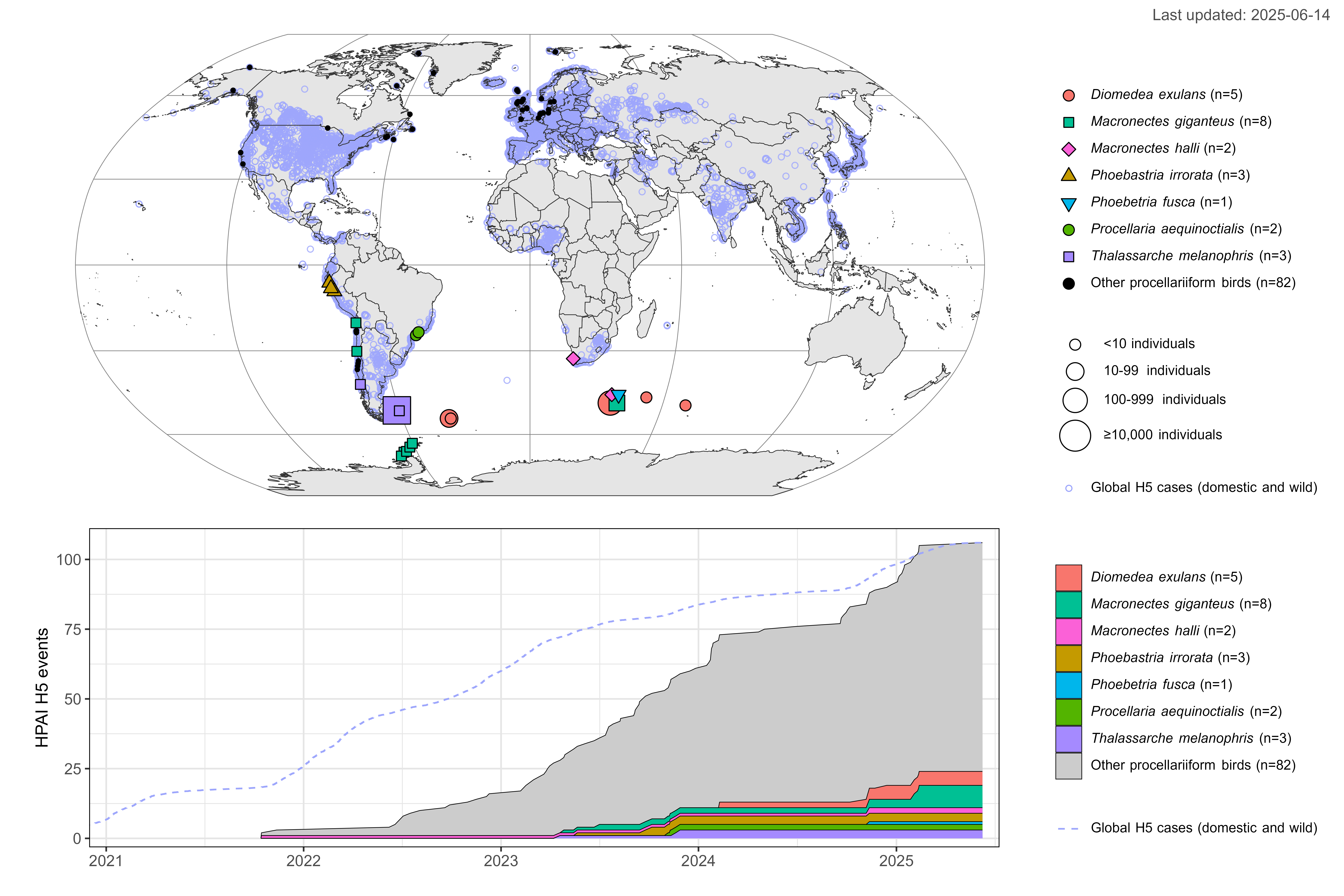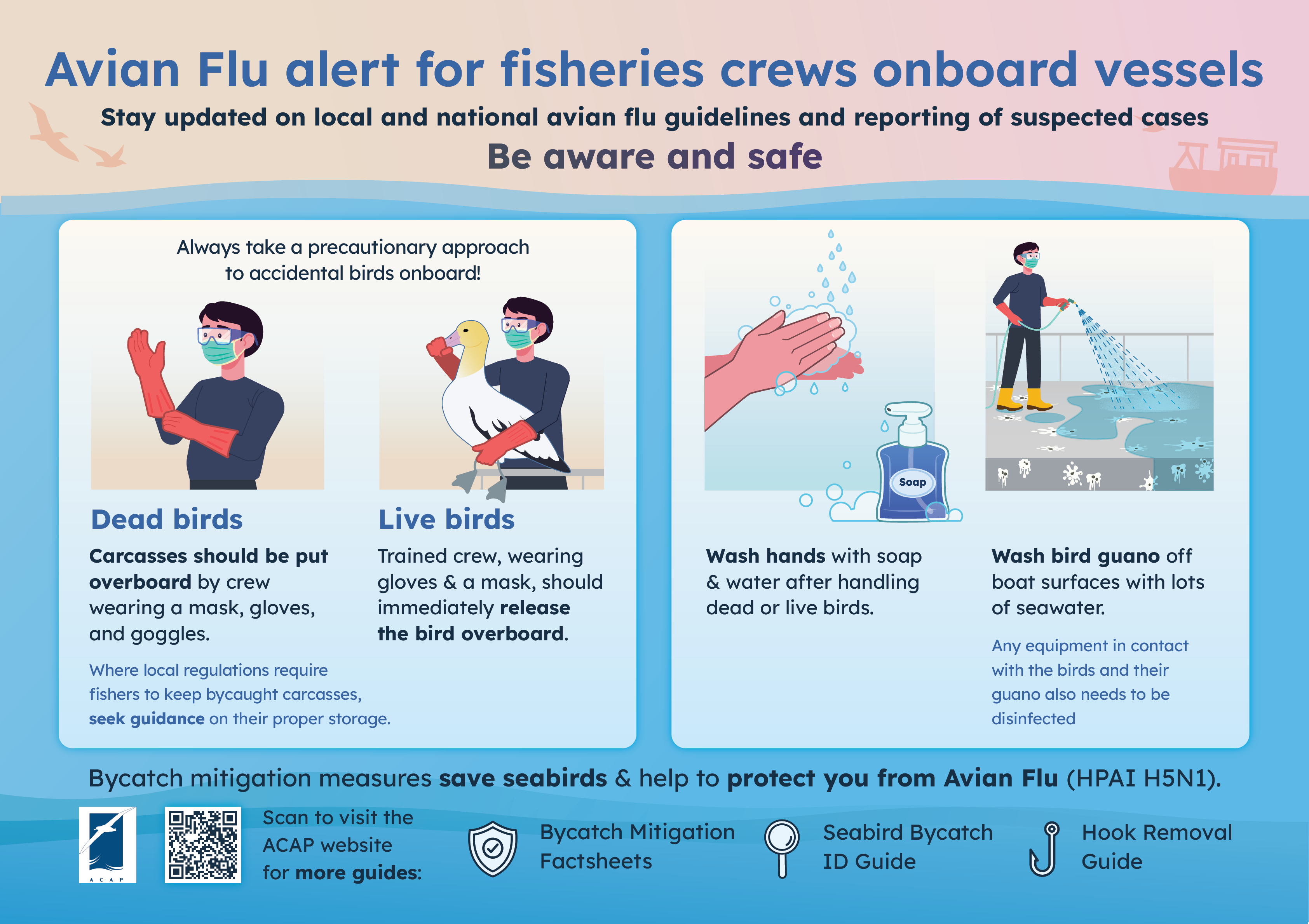Influenza aviaire
Current strains of high pathogenicity avian influenza (HPAI H5Nx) spread more rapidly and aggressively than previous variants, causing substantial impacts on both domestic and wild birds, and even infecting wild mammals. Since 2021, these strains have exhibited unprecedented global spread among seabird populations. The dynamic and unpredictable nature of avian influenza, particularly when it infects naïve populations, can lead to unforeseen consequences, and continuous outreach and information dissemination is needed. General biosecurity guidelines for wildlife professionals have been published by the WOAH/FAO Network of Expertise on Animal Influenza (OFFLU), the Scientific Committee on Antarctic Research (SCAR) and other key organizations have also provided valuable resources. However, these guidelines are often broad and may lack the specificity about Procellariiformes needed by professionals working directly with ACAP species or within their habitats, such as researchers, protected area managers, tourist guides, and onboard observers. Moreover, when encountering suspected HPAI cases in remote locations, these professionals frequently lack the basic knowledge or materials required to properly document and investigate such instances. Continuous efforts are essential to disseminate the most accurate information that supports the development of local and regional emergency plans. To this end, the ACAP intersessional group of experts on epidemiology, disease risk assessment, and management—established during AC13—plays a continuous role in advising ACAP on issues related to the ongoing high pathogenicity H5N1 avian influenza panzootic. In November of 2023 we updated the “Guidelines for working with albatrosses and petrels during the high pathogenicity avian influenza (HPAI) H5N1 panzootic” and we provide within the ACAP website an up-to-date map and list of cases in albatrosses, petrels, and shearwaters around the world. Recently, during the 7th International Albatross and Petrel Conference that happened in Mexico (IAPC7, May 2024), the group developed a hybrid workshop on HPAI H5Nx and Procellariiformes, that is now available on a virtual platform, with the intention that the recommendations from this group should be widely disseminated to ensure broader outreach.
Please stay alert for new resources published on this page by the ACAP intersessional group. As new information becomes available and our guidelines are updated, further communication from diverse perspectives will be essential. These initiatives are crucial to preventing the human-mediated spread of HPAI viruses to ACAP species, enhancing surveillance measures, and accurately assessing impacts on ACAP species.
Guidelines for working with albatrosses and petrels during high pathogenicity avian influenza (HPAI) H5Nx panzootic Updated November 2024
Directives pour les activités auprès d'albatros et de pétrels pendant l’épidémie d’influenza aviaire H5N1 Updated November 2023
Directrices para trabajar con albatros y petreles durante influenza aviar H5N1 Updated November 2023

Summary of recent HPAI cases in ACAP species (updated 14 June 2025).
 1 A dispute exists between the Governments of Argentina and the United Kingdom of Great Britain and Northern Ireland concerning sovereignty over the Falkland Islands (Islas Malvinas), South Georgia and the South Sandwich Islands (Islas Georgias del Sur y Islas Sandwich del Sur) and the surrounding maritime areas.
1 A dispute exists between the Governments of Argentina and the United Kingdom of Great Britain and Northern Ireland concerning sovereignty over the Falkland Islands (Islas Malvinas), South Georgia and the South Sandwich Islands (Islas Georgias del Sur y Islas Sandwich del Sur) and the surrounding maritime areas.
Q&A session and wet lab training for working with albatrosses and petrels during the on-going high pathogenicity H5N1 avian influenza outbreak
IAPC7 - Thursday, 23 May 2024, 1:30 PM – 6:00 PM. More information on: https://www.islas.org.mx/iapc7/
The workshop aligns with and expands upon the principles detailed in ACAP´s "Guidelines for working with albatrosses and petrels during the on-going high pathogenicity H5N1 avian influenza outbreak", aims to improve reaction and mitigation efforts concerning HPAI for albatrosses and petrels, and bolster international capacity for early detection and response while minimising further spread.
Watch the workshop here

ACAP Session includes: 00:00 Introduction
12:40 HPAI in albatrosses and petrels
52:26 Biosafety in practice
2:01:40 Vaccinating California Condors
2:30:05 HPAI vaccination in seabirds
DISCLAIMER: Surveillance measures dedicated to high pathogenicity avian influenza (HPAI H5Nx) diagnosis, monitoring, and reporting MUST be always in close dialogue and communication with the official veterinary services in each country of jurisdiction of seabird colonies and areas of aggregation.

 Français
Français  English
English  Español
Español 